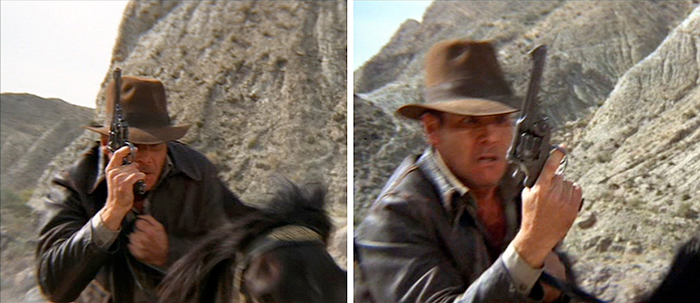The Webley Mk IV Revolver – A Legacy in Steel and Smoke
Share
Introduction
Few firearms have become as symbolically associated with the British Empire as the Webley revolver. With its stout profile, break-action design, and service across two World Wars, the Webley is both a historical artifact and a mechanical icon. Among its many iterations, the Webley Mk IV revolver stands out for its dual legacy: one version saw use during the Boer War in .455 caliber, and another, more compact .38/200 version became standard British military issue during World War II. This blog explores the evolution, usage, and cultural footprint of the Webley Mk IV, including its various versions, notable users, screen appearances, and the enduring appeal of the Denix non-firing replica.
The Birth of a Titan: Origins of the Webley Revolver
The Webley revolver lineage began in earnest with the founding of Webley & Scott, a British arms manufacturer whose roots go back to the late 18th century. Originally founded by William Davies, it was eventually taken over by his son-in-law, Philip Webley, who further advanced the business. Webley & Scott became famous for producing reliable and powerful revolvers, serving not just the British military but also police and civilian markets.
The first Webley to be officially adopted by the British Army was the Mk I in 1887, chambered in .455 Webley. Its top-break design and automatic extraction mechanism were revolutionary for their time, enabling fast reloading under combat conditions. Subsequent models refined the design further, with enhancements to the frame, lock mechanism, and grips.
By the time the Mk IV revolver appeared, Webley had already cemented its place as the standard sidearm of the British Empire. Two separate revolvers would bear the name Mk IV—one a .455-caliber weapon used in the Boer War, and the other, a scaled-down .38-caliber variant adopted in 1932.
The Webley Mk IV: Technical Overview and Design

The Webley Mk IV revolver came in two major forms. The earlier Mk IV, chambered in .455 Webley, was introduced in 1899 and saw action during the Second Boer War. It retained the solid, break-top design and heavy recoil of its predecessors. The more commonly referenced Mk IV, however, is the .38/200 caliber model, introduced in 1932 and designed to replace the larger .455 service revolvers.
This newer Mk IV was compact, more manageable in recoil, and suited to the evolving needs of interwar and WWII-era British forces. It featured:
-
Caliber: .38/200 (.38 S&W with a 200-grain bullet)
-
Action: Double-action revolver
-
Barrel length: Typically 5 inches
-
Weight: Approximately 1.9 lbs (unloaded)
-
Capacity: 6-round cylinder
-
Sights: Fixed front and rear notch
The break-action design allowed the revolver to be quickly opened for reloading. As the barrel pivoted downward, the ejector star pushed out all six spent cartridges simultaneously. This was ideal for battlefield conditions, where speed and reliability were paramount.

Evolution Through the Marks: Webley Variants
The Webley revolver series evolved through multiple “Marks” (designations), each reflecting incremental improvements: Webley Mark I circa 1887
Webley Mark I circa 1887
-
Mk I (1887): The original .455-caliber model, with a six-inch barrel and solid military build.
-
Mk II and III: Introduced minor internal changes and improved materials.
-
Mk IV (1899): The Boer War version chambered in .455, similar to the Mk III with cosmetic and mechanical tweaks.
-
Mk V (1913): Strengthened frame and new grip design.
-
Mk VI (1915): The definitive .455 model of WWI with a squared grip and six-inch barrel.
-
Mk IV (.38, 1932): Often called the “Webley Mk IV .38” or “Webley Mk IV Police,” this model was lighter, had less recoil, and was used throughout WWII.
Additionally, Webley produced variants for police use and export markets. The company also developed the Webley-Fosbery Automatic Revolver, an unusual semi-automatic revolver that was mechanically complex but offered rapid follow-up shots.
The Webley Mk IV in War

Second Boer War
The .455 Mk IV revolver debuted during the Boer War, proving itself in harsh African conditions. Officers and mounted troops valued its simplicity, reliability, and stopping power.
World War I
Although the Mk VI would become the iconic revolver of WWI, earlier models including the Mk IV were still used by officers and rear-echelon troops.
World War II
The .38 Mk IV became standard issue in 1932 and was widely used by British and Commonwealth forces during WWII. It offered less recoil than the .455 models, making it easier to handle and train with. Soldiers and officers alike carried it into battle across Europe, North Africa, and Asia. The round, while less powerful than the .455, was considered adequate when paired with the 200-grain lead bullet.
Post-War and Police Use
After the war, the Webley Mk IV saw service with police forces across the UK and Commonwealth nations. Its reliability made it a popular sidearm well into the 1960s.
Notable Carriers
-
Field Marshal Bernard Montgomery: Known to carry a Webley revolver
-
T.E. Lawrence (Lawrence of Arabia): Frequently depicted with a Webley
-
British Commandos and RAF officers: Regularly issued Webleys
Media and Pop Culture Appearances
The Webley Mk IV, along with the Mk VI, has had extensive representation in film and television due to its iconic silhouette and historical associations. It is often used to evoke a sense of British grit and imperial history.
Films
 Indiana Jones Carries the Webley
Indiana Jones Carries the Webley
-
Indiana Jones and the Last Crusade (1989): Indiana Jones carries a Webley Mk VI.
-
The Mummy (1999): Brendan Fraser’s character uses a Webley revolver.
-
Zulu (1964): British officers carry Webleys during the Anglo-Zulu War.
-
Lawrence of Arabia (1962): Shows T.E. Lawrence wielding a Webley.
Television
 Thomas Shelby With Webley from Peaky Blinders
Thomas Shelby With Webley from Peaky Blinders
-
Peaky Blinders: Characters frequently use Webleys, especially the Mk IV.
-
Downton Abbey: Features Webleys during wartime flashbacks.
Their distinct break-top design and sturdy construction make them immediately recognizable on screen, often lending authenticity to period pieces.
The Denix Non-Firing Webley Replica
Denix Non-Firing Replica of the Webley Mark IV
For collectors, reenactors, and film professionals, finding a real Webley Mk IV can be expensive and legally complex. Thankfully, Denix offers a high-quality non-firing replica that captures the essence of the Webley experience.
Notable Features
-
Full metal construction with a textured grip
-
Rotating cylinder: Mimics real loading and firing operations
-
Weight and dimensions: Close to the real thing for authenticity
Advantages of the non-firing version
-
Highly realistic: Ideal for display, reenactment, or props
-
No FFL required: Legal to own in most locations without a license
-
Durable construction: Made to withstand handling
-
Affordable: Much cheaper than acquiring a live firearm
-
Non-firing: Cannot be used for training or function testing
-
Finish wear: Paint may chip with heavy handling
-
No dry-firing durability: Internal mechanisms aren’t made for repeated trigger pulls
For most enthusiasts, these drawbacks are minimal compared to the benefits. The Denix Webley replica serves as an accessible way to own a piece of military history without the risks or costs associated with live firearms.
Conclusion
The Webley Mk IV revolver remains one of the most historically significant and visually iconic handguns in military history. From the dusty plains of South Africa to the ruined cities of World War II Europe, it served British and Commonwealth forces with reliability and style. It lives on not only in museums and private collections but also in pop culture and replica form.
Denix’s non-firing replica ensures that the legacy of the Webley Mk IV can continue to inspire collectors, filmmakers, and history buffs alike. Whether you are drawn to it for its cinematic charm, its wartime pedigree, or its mechanical elegance, the Webley Mk IV is a revolver worth remembering.
For anyone seeking to own a piece of this legacy, the Denix replica is an excellent place to start.

